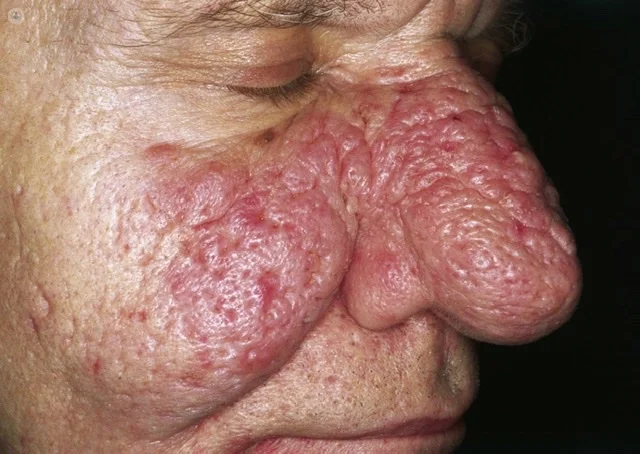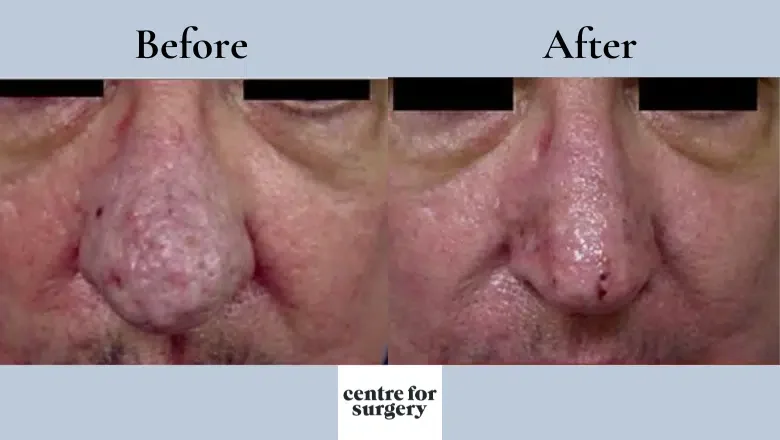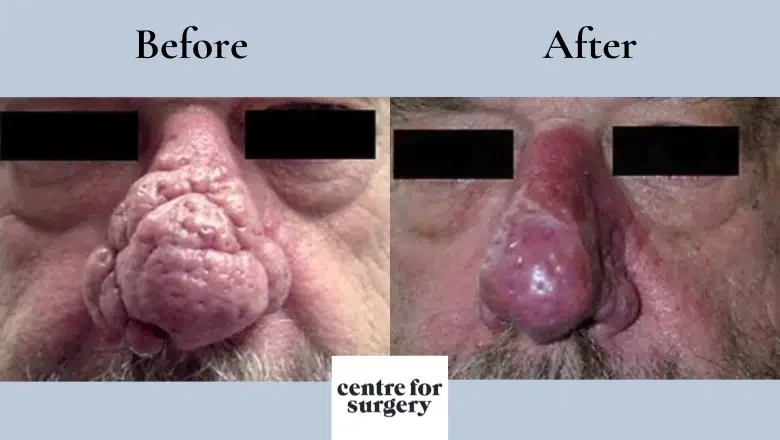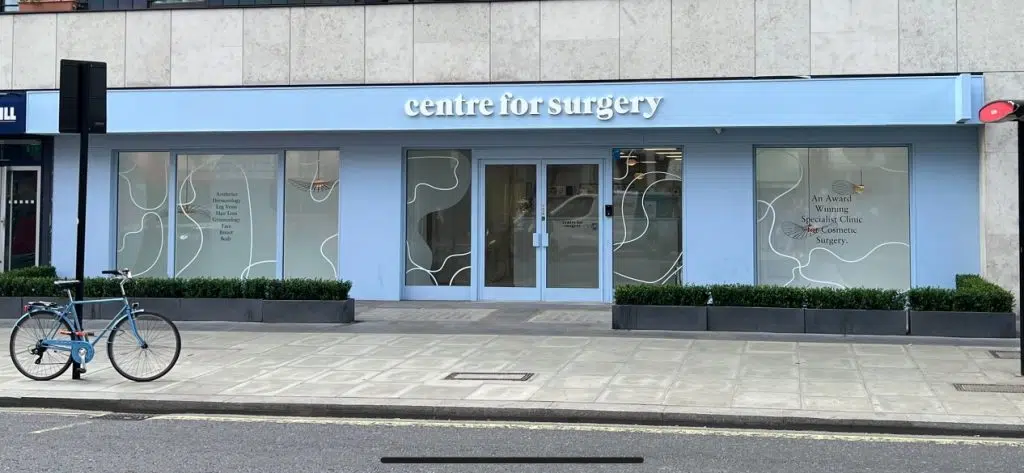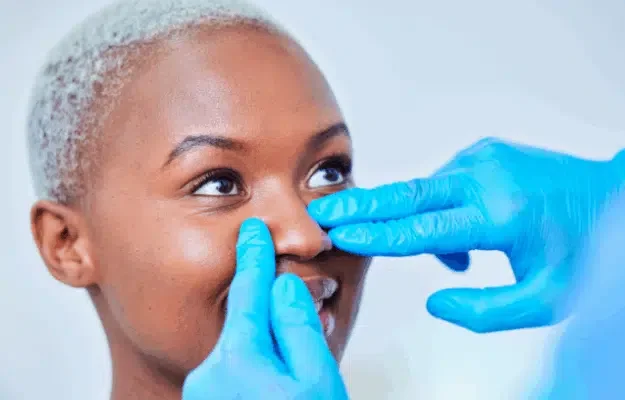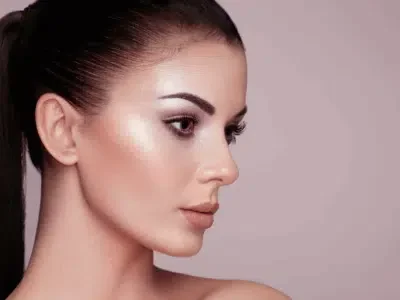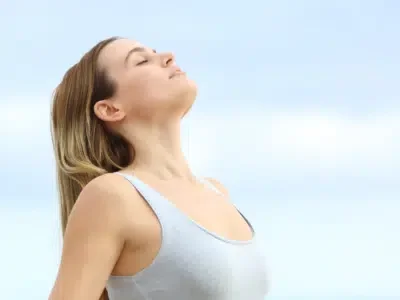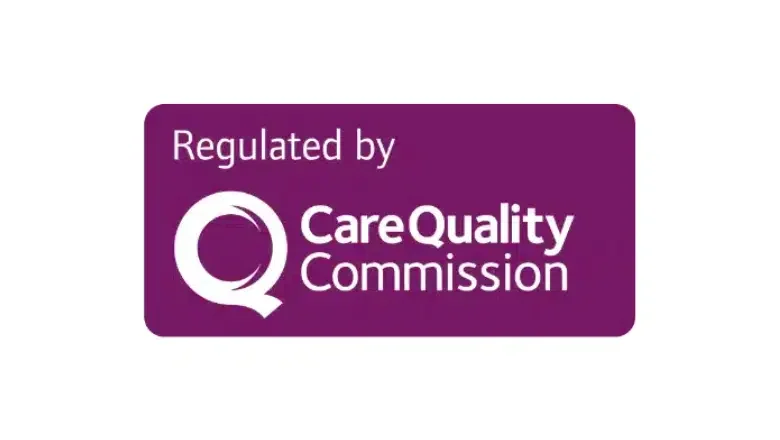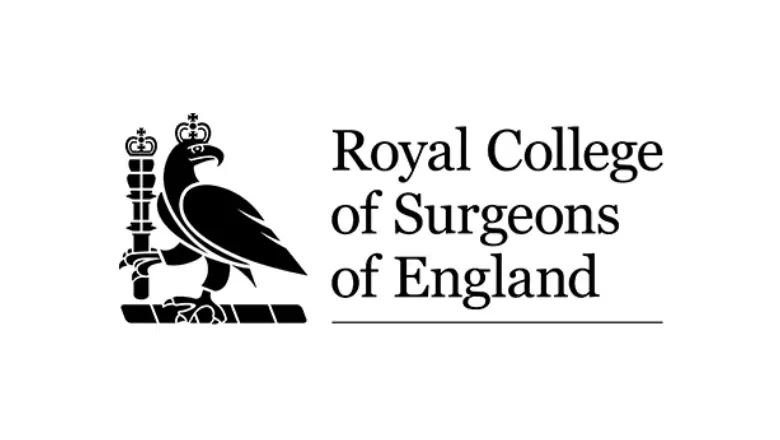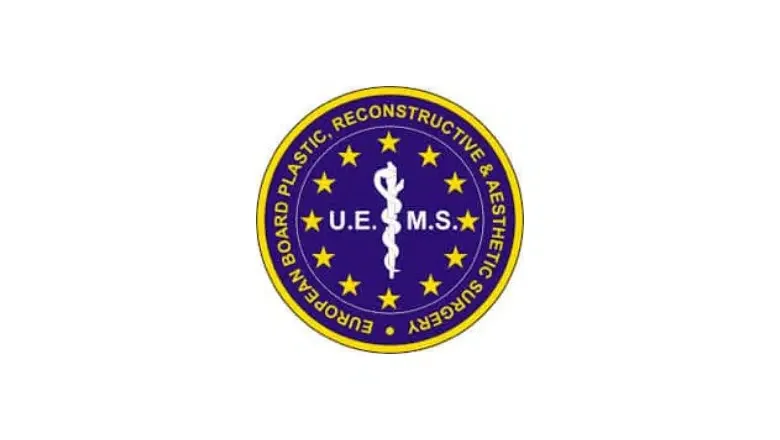Rhinophyma Surgery in London
Rhinophyma is a condition that causes the nose to become enlarged and deformed, most commonly seen in men over 50. It is a subtype of rosacea, a chronic skin condition that affects the face. Rhinophyma is caused by the thickening of the skin on the nose, as well as an increase in the number and size of sebaceous glands. This can result in a bulbous, red, and bumpy nose. It is important to note that while rhinophyma is often associated with heavy alcohol consumption, the link is not well established.
Treatment for rhinophyma typically involves reducing the size of the nose through surgical procedures such as excision, skin resurfacing, or laser therapy. The goal of treatment is to improve the patient’s appearance and self-esteem and to improve breathing by opening the nasal airway. In some cases, a combination of surgical and non-surgical treatments may be needed.
Dr Shehab Jabir - Specialist Facial Plastic Surgeon
Dr Shehab Jabir is a highly skilled plastic surgeon with specialist expertise in the surgical management of rhinophyma. Dr Jabir has developed advanced techniques to treat rhinophyma effectively, restoring both form and function.
His approach focuses on carefully removing the excess tissue while reshaping the underlying nasal structure to achieve a smoother, more natural contour. By combining precision surgery with an eye for facial balance, Dr Jabir delivers results that improve breathing where necessary and dramatically enhance the overall appearance of the nose.
Patients value his meticulous attention to detail and the reassurance he provides throughout the process, from the initial consultation through to recovery.
What is Rhinophyma?
Rhinophyma is a skin disorder that predominantly impacts the nasal area. It leads to an enlarged, bulbous nose that may appear reddish and bumpy or exhibit a mix of both characteristics. The precise origin of rhinophyma remains unclear, although scientific research suggests that it may emerge due to an undiagnosed and untreated severe form of rosacea, known as phymatous rosacea.
The progression of rhinophyma usually spans several years, during which the condition gradually evolves into a sizable mass, most often located at the nose’s tip. Early indications of rosacea can manifest as patchy redness on the cheeks and nose, intermittent facial flushing, skin sensitivity, or the emergence of small red bumps.
As rhinophyma progresses, it is typically marked by a slow-growing mass that causes the nose to become increasingly bulbous and distorted in shape. Additional symptoms can include a proliferation of oil glands, enlarged pores, reddened skin, and areas where the skin has thickened, become rougher, or developed a waxy appearance.
In the initial stages of rosacea, individuals may experience a variety of symptoms, such as red blotchy skin appearing on their cheeks and nose, sporadic episodes of facial flushing, heightened skin sensitivity, or the development of small red bumps. If left untreated, these early signs can eventually evolve into the more severe form of rhinophyma, so early diagnosis and treatment are crucial in managing this dermatological condition.
What Causes Rhinophyma?
The exact cause of rhinophyma is not well understood, but it is believed to be a complication of rosacea, a chronic skin condition that affects the face. Rosacea causes facial inflammation and redness, especially on the cheeks, nose, chin, and forehead. In some people, the condition can progress to rhinophyma, which is characterized by the thickening of the skin on the nose and an increase in the number and size of sebaceous glands.
Some risk factors have been associated with the development of rhinophyma, including:
- Age: It is most common in men over 50
- Gender: it is more common in men than in women
- Family history: people with a family history of rosacea or rhinophyma are more likely to develop the condition
- Ethnicity: it’s more common in people of Celtic or Scandinavian descent
- Exposure to UV rays and environmental factors like wind, sun, and cold temperatures.
Rhinophyma Reduction Before & After Photos
Case 1:
Case 2:
Can Rhinophyma Cause Snoring?
While rhinophyma itself is not directly linked to snoring, the condition can cause structural changes in the nose that may contribute to snoring or other breathing difficulties.
In some cases, rhinophyma can cause the nasal passages to become partially or completely blocked, making it more difficult to breathe through the nose. This can lead to snoring or other breathing problems during sleep.
In addition, rhinophyma can cause the nasal tissue to become inflamed, contributing to snoring or other breathing difficulties. It is important to note, however, that not all individuals with rhinophyma will experience snoring or other breathing problems.
Centre for Surgery offers highly effective laser snoring treatment, also known as NightLase, to help alleviate symptoms of snoring caused by rhinophyma.
Laser snoring treatment is a non-surgical, minimally invasive procedure that uses a laser to tighten the tissues in the back of the throat, reducing the vibration that causes snoring.
Benefits of Rhinophyma Treatment
The benefits of rhinophyma treatment are numerous and can significantly improve an individual’s quality of life. Some of the key advantages of seeking appropriate treatment for this dermatological condition include:
Improved appearance
One of the primary benefits of rhinophyma treatment is the enhancement of the patient’s appearance. As the condition can lead to a disfigured and bulbous nose, treatment can help reduce the size and redness of the affected area, leading to a more natural and aesthetically pleasing appearance.
Enhanced self-confidence
Rhinophyma, due to its visible nature, can significantly impact an individual’s self-esteem. By addressing the symptoms and improving the nose’s appearance, patients can experience a boost in self-confidence and a renewed sense of self-worth.
Better skin health
Treatment of rhinophyma can contribute to overall skin health by reducing inflammation, controlling excess oil production, and minimising enlarged pores. These improvements can lead to a healthier complexion and reduce the risk of further skin complications.
Improved respiratory function
In severe cases, rhinophyma can obstruct the nasal passages, leading to breathing difficulties. Treatment can help alleviate this issue by reducing the size of the nasal mass, allowing for improved airflow and better respiratory function.
Prevention of complications
Timely and appropriate treatment of rhinophyma can help prevent the progression of the condition and the development of complications, such as infections and further disfigurement of the nasal area.
Psychological well-being
Addressing the physical symptoms of rhinophyma can have a positive impact on an individual’s mental health. Relief from social anxiety and improvement in self-confidence can lead to enhanced psychological well-being and an overall better quality of life.
Customised treatment plans
Rhinophyma treatments can be tailored to suit each patient’s specific needs and preferences. This personalized approach ensures that individuals receive the most effective and appropriate care for their condition.
Am I suitable for rhinophyma surgery?
Whether or not you are suitable for rhinophyma surgery depends on several factors, including the severity of your condition, your overall health, and your personal goals for the surgery. A consultation with a plastic surgeon specialising in rhinophyma treatment will help determine if you are a good candidate for surgery.
During the consultation, the surgeon will assess the size and shape of your nose, the thickness of the skin, and the presence of any other medical conditions that may affect the outcome of the surgery. They will also discuss your goals for the surgery and explain the different surgical options available, including the risks, benefits, and potential outcomes of each.
It’s important to have realistic expectations and understand that rhinophyma surgery may not completely eliminate the redness, bumpiness, and irregular shape of the nose. However, it will improve its appearance and can also improve breathing by opening the nasal airway.
Surgery is not the only option for rhinophyma treatment; other non-surgical options, such as topical or oral medications or laser therapy, may be used alone or in combination with surgery.
Rhinophyma Removal Surgical Techniques
Several surgical techniques can be used to treat rhinophyma, each with its own advantages and disadvantages. The choice of technique will depend on the extent of the condition, the patient’s goals for the surgery, and the surgeon’s experience and expertise.
Some of the most common surgical techniques for rhinophyma include:
Surgical Excision
This technique involves removing the excess tissue from the nose using a scalpel or a surgical laser. This can be done through an open or closed approach, depending on the extent of the condition. This method is still the most effective technique but can leave a scar and may require a skin graft.
Dermaplaning
This technique involves using a surgical blade to shave off the excess tissue on the nose. This technique can be performed under local anaesthesia and is considered less invasive than other surgical methods.
Carbon dioxide (CO2) laser resurfacing
This technique uses a laser to remove the top layers of the skin on the nose, leaving behind a smoother and more even surface. It can also improve the skin’s texture and reduce the redness associated with rhinophyma.
Cryosurgery
This technique uses liquid nitrogen to freeze and destroy the excess tissue on the nose.
Subcision
This technique involves using a needle to separate the fibrous bands, pulling down the skin, and creating a bumpy texture.
Recovery after Rhinophyma Removal
Recovery after rhinophyma surgery varies depending on the surgical technique used, but generally, it can take several weeks for the swelling and bruising to subside and for the final results to become visible.
After the surgery, your surgeon will place a dressing or splint on your nose to help shape and protect the area during the healing process. They will also provide you with instructions for caring for the surgical site, including how to clean and protect the area and when to return for follow-up appointments.
You should expect some swelling and bruising around the nose, which can last for several weeks. Your surgeon may recommend medications to help manage pain and discomfort, and cold compresses can be used to help reduce swelling. The sutures will be removed after a week or two, and you will be able to resume normal activities after a week or two, but it is important to avoid strenuous activities or exposure to sunlight during the healing period.
Follow the postoperative instructions your surgeon provided and attend any scheduled follow-up appointments. During the healing process, try to be patient and avoid comparing your recovery to others, as every person’s healing process is different.
The final results of the surgery may not be visible for several months, and the nose may not be completely symmetrical. Still, the surgery will improve its appearance and can also improve breathing by opening the nasal airway.
Can I get Rhinophyma Treatment on the NHS?
The availability of rhinophyma surgery in the National Health Service (NHS) in the UK can vary depending on the specific NHS trust or region. Before considering surgery, non-surgical options like topical or oral medications or laser therapy are usually tried first.
To be considered for rhinophyma surgery on the NHS, a GP or a specialist must refer you and then be assessed by a specialist surgeon. They will evaluate your condition, and if they determine that surgery is the best option, they will refer you to a plastic surgeon who can perform the procedure.
The availability of the surgery on the NHS may also depend on the funding and resources available in your area. Some NHS trusts may not offer surgery for rhinophyma or may have a long waiting list for the procedure. However, some patients may be able to get a referral for surgery on the NHS if they have a severe or debilitating case of rhinophyma or if other treatment options have failed.
Rhinophyma Surgery at Centre for Surgery
Centre for Surgery is a specialist plastic surgery clinic and is home to some of the leading specialists in rhinophyma surgery in the UK. We regularly treat both men and women with rhinophyma of all grades of severity using gold-standard surgical techniques.
Schedule a rhinophyma consultation by calling us on 020 7993 4849 or completing the contact form below.
FAQs
-
What is rhinophyma?Rhinophyma is a chronic skin condition that mainly affects the nose. Over a period of time the skin of the nose gradually thickens and the sebaceous glands within the skin become larger. Although the skin may have a normal colour, there are often visible blood vessels that gives rise to the red appearance. In more advanced cases of rhinophyma the skin develops a pitted appearance and often develops a significant bulbous appearance. Severe cases of rhinophyma even result in functional disturbances with breathing. Rhinophyma is often linked with rosacea which is an inflammatory chronic skin condition of the face.
-
How is rhinophyma diagnosed?Rhinophyma often develops when rosacea, a prevalent skin disorder characterized by skin inflammation, remains undiagnosed and untreated, leading to a more severe manifestation of the condition. Rosacea typically results in red, blotchy skin, particularly on the cheeks and nose, and can sometimes cause red bumps resembling pimples.
Due to its similarities to acne or other skin conditions, rosacea can easily be misidentified, leaving it undiagnosed and increasing the risk of progressing to rhinophyma.
To determine whether an individual has rhinophyma, in-person consultation with an experienced surgeon at Centre for Surgery is necessary. The medical professional will likely be able to diagnose rhinophyma through a physical examination and by reviewing the patient's medical history. In certain rare instances, a skin biopsy may be needed to confirm the diagnosis.
It is crucial to accurately diagnose and treat rosacea early to prevent the development or progression of rhinophyma. Collaborating with our surgeon to develop a personalised treatment plan can help manage the condition effectively and maintain overall skin health. -
What treatment is used for rhinophyma?The best treatment for rhinophyma is ablative laser treatment. Both erbium and CO2 laser are highly effective treatments for reducing and reshaping the size of the nose.
Older treatments include dermabrasion and scalpel excision combined with cautery. These treatments lack precision and have a higher risk of scarring compared with laser treatment. -
What does treatment for rhinophyma involve?Rhinophyma treatment is most commonly performed under local anaesthetic. Topical numbing cream is first applied to the nose. Your dermatologist will then use injections of a local anaesthetic to fully numb the news. Once the local anaesthetic has had time to work, the rhinophyma treatment is virtually painless. The dermatologist will then apply a CO2 laser or erbium laser to the skin of the nose. During treatment, patients are awake and fully comfortable. With a laser, the extra tissue on the nose will be removed layer by layer. The laser is applied with a number of different techniques depending on whether there are localised or generalised areas of skin excess.
-
Is rhinophyma surgery painful?The extent of the procedure and the associated pain can vary depending on the individual case and the surgical technique used.
In general, rhinophyma surgery is performed under local anaesthesia or general anaesthesia, and patients are typically given pain medications to manage any discomfort after the procedure. While some mild pain and discomfort are normal after the procedure, it is usually well-controlled with pain medication and typically resolves within a few days.
Some patients may experience swelling and bruising after the procedure, which can also cause some discomfort. However, this is usually temporary and resolves within a few days to a few weeks after the surgery. -
What happens after rhinophyma treatment?Following laser treatment for rhinophyma, the dermatologist will apply Aquaphor cream or alternatively paraffin jelly to the surface of the nose to act as a protective barrier. Paraffin jelly must be applied for a full two weeks after treatment at regular intervals. It is important to clean the nose with twice daily washing followed by reapplication of paraffin jelly. The skin of their nose will begin to regenerate and initially may appear red or pink in appearance. The colour will return to normal after approximately three months.
-
How many rhinophyma reduction treatments will I need?Rhinophyma treatment using laser usually only needs one treatment. For more complex or large rhinophyma cases, a second procedure may be required for any residual areas of overgrown tissue.
-
How Much Does Rhinophyma Removal Cost?The cost of rhinophyma removal surgery is influenced by various factors, including the complexity of the individual case. To obtain an accurate cost estimate, it is essential to schedule a consultation with a qualified surgeon.
During the consultation, the medical professional will assess the severity of your rhinophyma, discuss the appropriate treatment options, and provide a personalised cost estimate based on the specifics of your situation. The final price may vary depending on factors such as the surgical technique used, the surgeon's expertise, the facility's fees, and any additional post-operative care required.
It is crucial to remember that investing in rhinophyma removal surgery can significantly improve your quality of life, self-confidence, and overall well-being. -
Can rhinophyma come back?Rhinophyma has the potential to come back if left untreated or inadequately managed, even after surgical intervention. Nevertheless, there are several measures that individuals can take to minimize the likelihood of the condition returning. Establishing a consistent and effective skincare regimen aimed at reducing excessive oil or sebum production is perhaps the most effective approach for preventing rhinophyma recurrence. Consistent use of sunscreen is also recommended to protect the skin from harmful UV rays.
In addition to skincare practices, other preventive tactics involve minimizing factors that can contribute to increased facial blood flow and rosacea flare-ups. Some examples include avoiding specific foods and beverages known to trigger rosacea, as well as steering clear of overly strenuous physical activities. However, it is important to note that the exact cause of rhinophyma remains uncertain, and as such, there is no universally recognized method for preventing its recurrence at this time.

